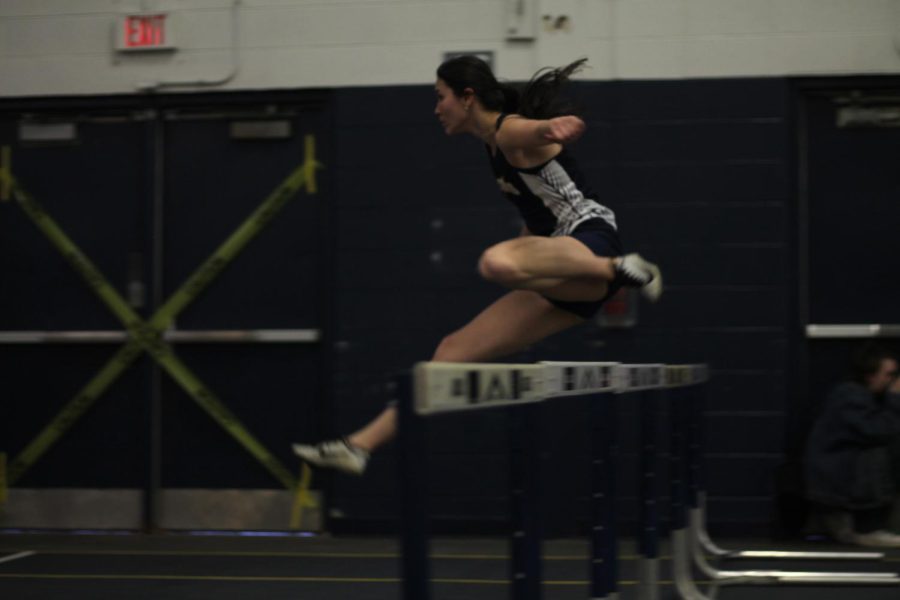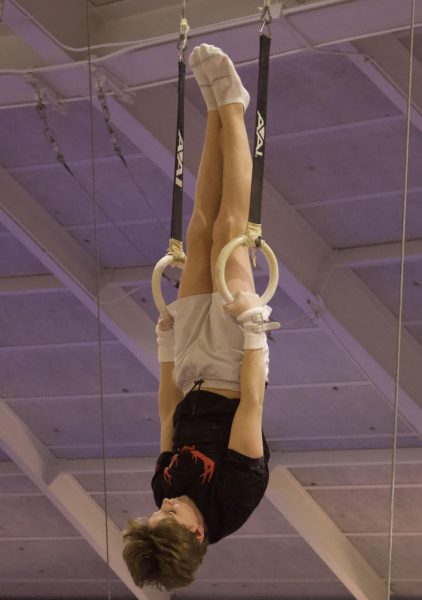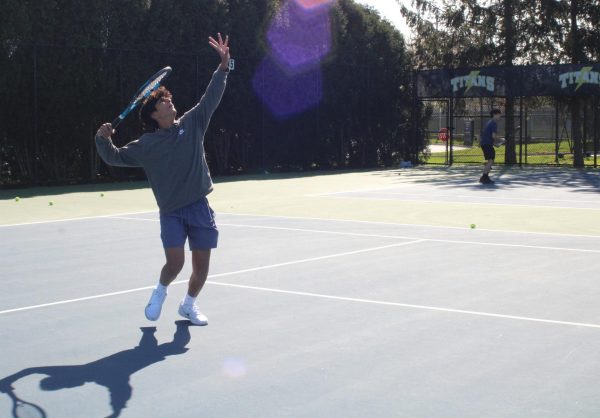We run this
March 17, 2023
Everyday after school, the boys’ and girls’ track and field teams pack nearly 300 athletes into the fieldhouse for practice. In high school track, running events range from the 50-meter dash to the 3200-meter run (about two miles). Track also includes field events: long jump, high jump, pole vault, triple jump, and shotput. Each of these columns discuss a different group of events to showcase the variety that exists in track and field.
Shot Put
Angela Karavites
It was by random chance that I ended up doing shot put, and it was all due to my sixth-grade English teacher and track coach. As an indecisive person, I had no idea what events to do. When I started track and field, my teacher and coach encouraged me to start shot put, and I loved it.
Since then, I have immersed myself in shot put. When most people think about shot put, they focus on the literal sense of the sport: throwing an eight-pound metal ball as far as possible. However, the mental challenge, rather than the physical one, is what makes it unique. Though it’s essential to learn technique and weight train to gain strength, once I enter the ring to do my shot I rely on instincts rather than technique. This strategy helped me to pass my “throwing bubble” of 28 feet and break 30 feet during regionals last spring.
My favorite part about track is my teammates. They bring a chaotic, funny energy. Between practices and meets, the shot put team spends a lot of time together, which has created many unforgettable moments and traditions. One of the newer traditions, and my personal favorite, is the daily after-practice selfie. At the end of every practice, we take a photo with my coach no matter where we are.
Being a part of this team has taught me that to be the best thrower is not throwing the farthest distance, but giving it your all and helping others achieve that as well.
Hurdles
Audrey Walch
I was aware that I was really tall for my age, so in middle school, I started hurdles. My height is a big advantage in getting over the hurdles. Despite the grassy “track” we had, I still thought it was a fun event to compete in. Despite the fun I had in middle school competing in the hurdles, I chose to pursue soccer my freshman year instead of track because that was the sport I prioritized. A year later, however, I felt myself gravitating towards hurdles after quitting soccer sophomore year.
From the beginning of my time hurdling, I’ve been competitive. I constantly look for ways to improve, especially in the 300 meter low hurdles. The 300 meter hurdles has a mix of my strengths in both sprint endurance and hurdle mobility. It’s an event that doesn’t come easy to most, but it’s a good challenge that gives me the opportunity to look more closely at how I can improve.
Hurdles are so different from every other event because when I run, I need a certain mindset. When I run hurdles, I have a constant running list of what I need to fix before every race, practicing changes to those issues, and learning to shut my brain off during the race. For most events, when you start overthinking your movements, you slow down and lose time. With hurdles, though, overthinking can be really dangerous. When I first started hurdles, I didn’t really understand this concept and constantly thought about what I needed to fix. That mixed with my fear led to tripping on hurdles, and various cuts and bruises on my knees because of it.
The most challenging aspect of hurdles by far are the mental blocks that come with it. All of last year I was working towards taking three steps in between each hurdle in the 100 meter hurdles. I knew I had the technique. It was a matter of my mind letting me break that pattern I had encrypted of constantly four stepping in between each hurdle. It wasn’t until late in the summer last year that I was finally able to get used to the new pattern and break my old mental block. Now I can three step with little to no issues.
Though they were challenging, the mental blocks I experienced helped me learn patience. Everyone wants to have natural talent as soon as they join something. Though I was athletic when I joined track, I was by no means the best on the team. The past few years of hard work, practicing, and learning have taught me that a lot of things don’t come easily. However, being able to see a lot of that hard work pay off I can say is one of the most rewarding things I have ever experienced.
Distance
Maggie Jortberg
Distance running runs in my family. All of my siblings ran cross country and track at South, so freshman year, with their encouragement, I started running distance as well. Though I originally started because of my family, distance running is something that’s become a part of who I am.
What makes distance unique is the amount of work we put in during every single practice. I run about 30 miles a week, and although I love running, there’s a physical and mental stamina required to do a long run or a set of 400 meter repeats after a seven hour school day.
All of this training has led to some amazing races. My favorite race I’ve ever run was the 1600 meter race at outdoor sectionals last year. My goal was to beat a 5:30 time, and I finished the race with a 5:25. I was overjoyed, realizing that all the hard work I’d put in that season paid off with a record time I was incredibly proud of.
Though I’ve experienced some incredible successes in terms of racing and time improvements, what I’ve loved most about track is the amazing distance team.
The difficulty that the distance team experiences together during practice brings us all closer together. There’s nothing quite like running eight miles together to really get to know someone. Along with that, most of the distance team runs cross country in the fall, so we are all very close even at the start of the track season.
Though track may seem like an individual sport, a tight-knit team is essential to everyone’s success. From cheering on every runner during races, to encouraging each other during speed workouts, to running relays like the 4 x 800 meter together, my teammates lift me up and make me a better runner.
Next year, I’ll be running track and cross country at Marquette University, and I hope that my team there is as solid and supportive as the one I’ve experienced at South. Track has taught me a lot about being a part of a team and supporting all of my teammates, which in turn has made me a better friend and an overall better person. I’ve loved the time I’ve spent with South, and I’m looking forward to my final outdoor season and the next four years of distance running in college.
Sprints
Benjamin Freidinger
I did not plan to run track in high school. I thought I would run cross country in the fall, and play volleyball each spring. Volleyball runs in my family; my mom played volleyball in high school, all three of my older siblings played in high school, and I started playing club volleyball in sixth grade. In the winter of my freshman year, I decided to try indoor track. I spent almost three months with a bunch of guys I did not know very well, and in that short time, my sports plans in high school were completely changed.
There were a few factors that compelled me to drop a sport I thought I would play for years for track. The biggest reason was the camaraderie of the team. Near the end of the indoor season, Covid-19 hit, school shut down, and all spring sports got canceled. Despite this massive hurdle, a group of upperclassmen led impromptu practices nearly every day to stay in shape. It was always fun to go out and train because the group had such a great relationship.
Few sports allow for exposure to students in other grades in the way that track does; runners train with members of their event group, not a group at the same level, meaning that all the sprinters train together, weather they are on junior varsity, varsity, or on an underclassmen team.
Another reason for my switch was the goal of track: personal improvement. Much like with weightlifting, in track, you can constantly see how you are getting better. It is encouraging to see your times improve as you work hard. This is also a source of motivation: if you keep working harder, you can keep improving, succeeding, and winning.
Jumps
Matthew Nugent
Eight steps from the chalk mark to the jumping off point. I remind myself of this number before every jump.
To long jump properly, you have to jump from exactly the right point from the edge of the board, a marked line. If you jump too early, you lose valuable inches from the length of your jump, and if you jump too late and your foot is over the board, your jump doesn’t count.
I started cross country my freshman year, but as winter brought the track season, I realized I wanted to try something new. On the first day of track, I switched from long distances to shorter. I enjoyed the 50-meter indoors and the 100-meter outdoors. I wanted to expand the number of events I competed in,so I decided to try long jump.
For me, long jumping was the natural extension of sprinting because of the strength and speed necessary for both. Long jumping is, in simple terms, just a short sprint with a jump tacked on to the end. When I started jumping, I enjoyed it even more than sprinting.
My junior year, I started competing in the triple jump. Because of its challenging hop, skip, jump pattern, learning proper triple jump form can be a huge learning curve. Unlike the long jump, the triple is a series of three continuous jumps. The first is the “hop”, where you land on the same foot you pushed off of; the second is the “skip”, where you land on the opposite foot you pushed off of; the third, or “jump” phase, looks similar to a regular long jump. Properly performing these steps is difficult at first, and injuries are common. In fact, while I was first learning to triple jump, I sprained my Achilles tendon.
The long and triple jumps are tests in precision. There’s a short amount of time to execute a great jump at a fast speed. You need to have the perfect starting position and the perfect number of steps. When you’re in the air, every movement is designed to reduce air resistance, and help you go as far as possible. Even landing in the sand pit has to be a thought-out series of movements. In these jumps, the total distance is measured from the board you push off of to the first mark in the sand, so if you mess up the landing, you lose length off of the jump’s total distance. Jumping has taught me perseverance and consistency through countless run-throughs and practice jumps.
I’ve loved jumping, especially the long jump, ever since I’ve started. When I run down the track towards the jump pit, it feels like I’m on a runway, preparing to take flight. The speed and excitement of the long jump is a thrill that I’ll always love.









